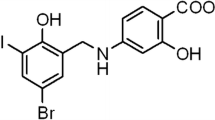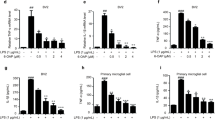Abstract
Under normal conditions in the brain, microglia play roles in homeostasis regulation and defense against injury. However, over-activated microglia secrete proinflammatory and cytotoxic factors that can induce progressive brain disorders, including Alzheimer’s disease, Parkinson’s disease and ischemia. Therefore, regulation of microglial activation contributes to the suppression of neuronal diseases via neuroinflammatory regulation. In this study, we investigated the effects of acacetin (5,7-dihydroxy-4′-methoxyflavone), which is derived from Robinia pseudoacacia, on neuroinflammation in lipopolysaccharide (LPS)-stimulated BV-2 cells and in animal models of neuroinflammation and ischemia. Acacetin significantly inhibited the release of nitric oxide (NO) and prostaglandin E2 and the expression of inducible NO synthase and cyclooxygenase-2 in LPS-stimulated BV-2 cells. The compound also reduced proinflammatory cytokines, tumor necrosis factor-α and interleukin-1β, and inhibited the activation of nuclear factor-κB and p38 mitogen-activated protein kinase. In an LPS-induced neuroinflammation mouse model, acacetin significantly suppressed microglial activation. Moreover, acacetin reduced neuronal cell death in an animal model of ischemia. These results suggest that acacetin may act as a potential therapeutic agent for brain diseases involving neuroinflammation.




Similar content being viewed by others
References
Ha SK, Lee P, Park JA, Oh HR, Lee SY, Park JH, Lee EH, Ryu JH, Lee KR, Kim SY (2008) Apigenin inhibits the production of NO and PGE2 in microglia and inhibits neuronal cell death in a middle cerebral artery occlusion-induced focal ischemia mice model. Neurochem Int 52(4–5):878–886
Ha SK, Moon E, Kim SY (2010) Chrysin suppresses LPS-stimulated proinflammatory responses by blocking NF-κB and JNK activations in microglia cells. Neurosci Lett 485(3):143–147
Lee H, Kim YO, Kim H, Kim SY, Noh HS, Kang SS, Cho GJ, Choi WS, Suk K (2003) Flavonoid wogonin from medicinal herb is neuroprotective by inhibiting inflammatory activation of microglia. FASEB J 17(13):1943–1944
Cody V (1988) Crystal and molecular structures of flavonoids. Prog Clin Biol Res 280:29–44
Pan MH, Lai CS, Wang YJ, Ho CT (2006) Acacetin suppressed LPS-induced up-expression of iNOS and COX-2 in murine macrophages and TPA-induced tumor promotion in mice. Biochem Pharmacol 72(10):1293–1303
Liao YH, Houghton PJ, Hoult JR (1999) Novel and known constituents from Buddleja species and their activity against leukocyte eicosanoid generation. J Nat Prod 62(9):1241–1245
Kraft C, Jenett-Siems K, Siems K, Jakupovic J, Mavi S, Bienzle U, Eich E (2003) In vitro antiplasmodial evaluation of medicinal plants from Zimbabwe. Phytother Res 17(2):123–128
Singh RP, Agrawal P, Yim D, Agarwal C, Agarwal R (2005) Acacetin inhibits cell growth and cell cycle progression, and induces apoptosis in human prostate cancer cells: structure-activity relationship with linarin and linarin acetate. Carcinogenesis 26(4):845–854
Block ML, Hong JS (2005) Microglia and inflammation-mediated neurodegeneration: multiple triggers with a common mechanism. Prog Neurobiol 76(2):77–98
Perry VH, Gordon S (1988) Macrophages and microglia in the nervous system. Trends Neurosci 11(6):273–277
Hanisch UK (2002) Microglia as a source and target of cytokines. Glia 40(2):140–155
Minghetti L, Levi G (1998) Microglia as effector cells in brain damage and repair: focus on prostanoids and nitric oxide. Prog Neurobiol 54(1):99–125
Gonzalez-Scarano F, Baltuch G (1999) Microglia as mediators of inflammatory and degenerative diseases. Annu Rev Neurosci 22:219–240
Tak PP, Firestein GS (2001) NF-κB: a key role in inflammatory diseases. J Clin Invest 107(1):7–11
Schieven GL (2005) The biology of p38 kinase: a central role in inflammation. Curr Top Med Chem 5(10):921–928
Waetzig V, Czeloth K, Hidding U, Mielke K, Kanzow M, Brecht S, Goetz M, Lucius R, Herdegen T, Hanisch UK (2005) c-Jun N-terminal kinases (JNKs) mediate pro-inflammatory actions of microglia. Glia 50(3):235–246
Park JS, Woo MS, Kim SY, Kim WK, Kim HS (2005) Repression of interferon-gamma-induced inducible nitric oxide synthase (iNOS) gene expression in microglia by sodium butyrate is mediated through specific inhibition of ERK signaling pathways. J Neuroimmunol 168(1–2):56–64
Blasi E, Barluzzi R, Bocchini V, Mozzolla R, Bistoni F (1990) Immortalization of murine microglial cells by a v-raf/v-myc carrying carrying retrovirus. J Neuroimmunol 27(2–3):229–237
Cho KO, Kim SK, Cho YJ, Sung KW, Kim SY (2007) Regional differences in the neuroprotective effect of minocycline in a mouse model of global forebrain ischemia. Life Sci 80(22):2030–2035
Fernandez AP, Pozo-Rodrigalvarez A, Serrano J, Martinez-Murillo R (2010) Nitric oxide: target for therapeutic strategies in Alzheimer’s disease. Curr Pharm Des 16(25):2837–2850
Aquilano K, Baldelli S, Rotilio G, Ciriolo MR (2008) Role of nitric oxide synthases in Parkinson’s disease: a review on the antioxidant and anti-inflammatory activity of polyphenols. Neurochem Res 33(12):2416–2426
Parmentier S, Bohme GA, Lerouet D, Damour D, Stutzmann JM, Margaill I, Plotkine M (1999) Selective inhibition of inducible nitric oxide synthase prevents ischaemic brain injury. Br J Pharmacol 127(2):546–552
Giovannini MG, Scali C, Prosperi C, Bellucci A, Pepeu G, Casamenti F (2003) Experimental brain inflammation and neurodegeneration as model of Alzheimer’s disease: protective effects of selective COX-2 inhibitors. Int J Immunopathol Pharmacol 16(2 Suppl):31–40
Barone FC, Feuerstein GZ (1999) Inflammatory mediators and stroke: new opportunities for novel therapeutics. J Cereb Blood Flow Metab 19(8):819–834
Samson Y, Lapergue B, Hosseini H (2005) Inflammation and ischaemic stroke: current status and future perspectives. Rev Neurol (Paris) 161(12 Pt 1):1177–1182
Acknowledgments
This work was supported by a grant from the Kyung Hee University Post-Doctoral Fellowship program in 2009 (KHU-20090448).
Conflict of interest
The authors declare that there are no conflicts of interest.
Author information
Authors and Affiliations
Corresponding author
Rights and permissions
About this article
Cite this article
Ha, S.K., Moon, E., Lee, P. et al. Acacetin Attenuates Neuroinflammation via Regulation the Response to LPS Stimuli In Vitro and In Vivo. Neurochem Res 37, 1560–1567 (2012). https://doi.org/10.1007/s11064-012-0751-z
Received:
Revised:
Accepted:
Published:
Issue Date:
DOI: https://doi.org/10.1007/s11064-012-0751-z




